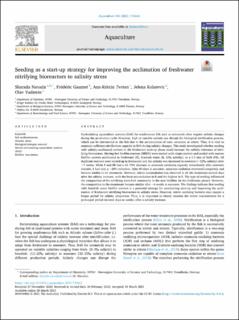| dc.contributor.author | Navada, Sharada | |
| dc.contributor.author | Gaumet, Frederic | |
| dc.contributor.author | Tveten, Ann-Kristin | |
| dc.contributor.author | Kolarevic, Jelena | |
| dc.contributor.author | Vadstein, Olav | |
| dc.date.accessioned | 2021-05-25T07:41:29Z | |
| dc.date.available | 2021-05-25T07:41:29Z | |
| dc.date.created | 2021-05-21T12:58:57Z | |
| dc.date.issued | 2021 | |
| dc.identifier.citation | Aquaculture. 2021, 540, . | en_US |
| dc.identifier.issn | 0044-8486 | |
| dc.identifier.uri | https://hdl.handle.net/11250/2756162 | |
| dc.description.abstract | Recirculating aquaculture systems (RAS) for anadromous fish such as salmonids often require salinity changes during the production cycle. However, high or variable salinity can disrupt the biological nitrification process, which can be detrimental to the fish due to the accumulation of toxic ammonia or nitrite. Thus, it is vital to maintain sufficient nitrification capacity in RAS during salinity changes. This study investigated whether seeding with salinity-acclimated carriers in the freshwater start-up phase could increase the salinity tolerance of nitrifying bioreactors. Moving bed biofilm reactors (MBBR) were started with virgin carriers and seeded with mature biofilm carriers acclimated to freshwater (F), brackish water (B, 12‰ salinity), or a 1:1 mix of both (FB). All duplicate reactors were started up in freshwater and the salinity was increased to seawater (~32‰ salinity) after ~7 weeks. While F and FB had a 65–75% decrease in ammonia oxidation capacity immediately after seawater transfer, B had only a ~20% reduction. After 40 days in seawater, ammonia oxidation recovered completely and became similar in all treatments. However, nitrite accumulation was observed in all the treatments several days after the salinity increase, with the least accumulation in B and the highest in F. The type of seeding influenced the composition of the nitrifying microbial community in the new biofilms (in the freshwater phase). However, the composition in the treatments became similar after ~6 weeks in seawater. The findings indicate that seeding with brackish water biofilm carriers is a potential strategy for accelerating start-up and improving the acclimation of freshwater nitrifying bioreactors to salinity stress. However, nitrite oxidizing bacteria may require a longer period for salinity adaptation. Thus, it is important to closely monitor the nitrite concentration for a prolonged period (several days or weeks) after a salinity increase. | en_US |
| dc.language.iso | eng | en_US |
| dc.publisher | Elsevier Science | en_US |
| dc.rights | Navngivelse 4.0 Internasjonal | * |
| dc.rights.uri | http://creativecommons.org/licenses/by/4.0/deed.no | * |
| dc.title | Seeding as a start-up strategy for improving the acclimation of freshwater nitrifying bioreactors to salinity stress | en_US |
| dc.type | Peer reviewed | en_US |
| dc.type | Journal article | en_US |
| dc.description.version | publishedVersion | en_US |
| dc.source.volume | 540 | en_US |
| dc.source.journal | Aquaculture | en_US |
| dc.identifier.doi | 10.1016/j.aquaculture.2021.736663 | |
| dc.identifier.cristin | 1911307 | |
| dc.description.localcode | This is an open access article distributed under the terms of the Creative Commons CC-BY license, which permits unrestricted use, distribution, and reproduction in any medium, provided the original work is properly cited. | en_US |
| dc.source.articlenumber | 736663 | en_US |
| cristin.ispublished | true | |
| cristin.fulltext | original | |
| cristin.qualitycode | 1 | |

